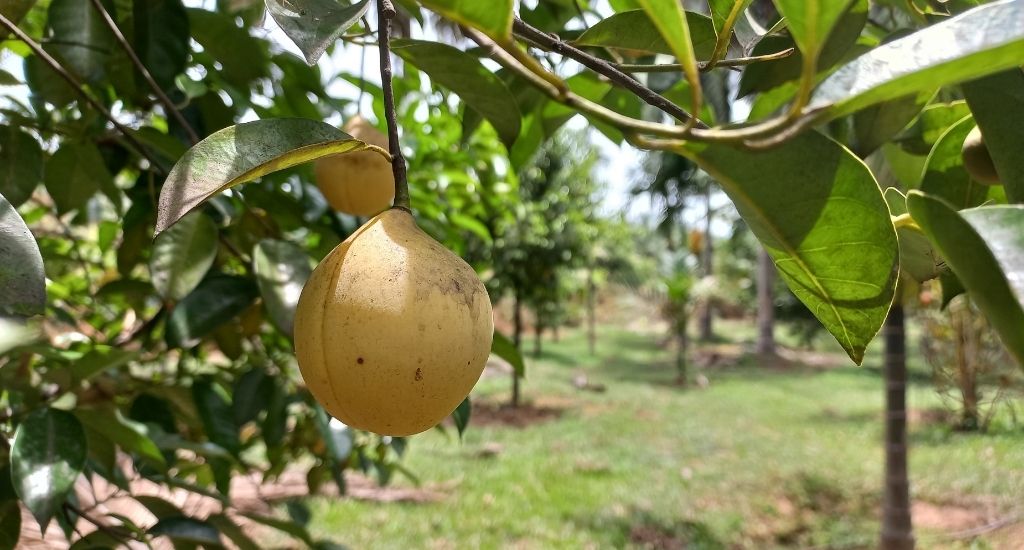Sibling spices nutmeg and mace have been adding victory points to the cooking game for long. However, the farmers of Pollachi had long remained oblivious to the charms of the valuable intercrop that grows as a companion to the towering coconut trees that grow abundantly in this lush landscape of Coimbatore district of Tamil Nadu.
Pollachi lies 15km from Anaimalai town, famed for the tiger reserve and a Western Ghats mountain range named after it. The region gets a fair amount of rainfall due to its proximity to the Western Ghats. This land is enriched by its numerous rivers, rivulets and reservoirs that ensure there’s no water scarcity, helping the region establish itself as one of India’s prime coconut cultivation zones. It is famed for its coir product exports worth crores of rupees.
Pollachi is also a serene gateway to Tamil Nadu from central and eastern parts of Kerala, which has nurtured a rich heritage of nutmeg cultivation and is the country’s top producer of the spice. To give a perspective, Tamil Nadu produces just around one percent of Kerala’s annual yield.

While coconut farming had always been Pollachi’s primary occupation, the nutmeg story hadn’t unravelled until the 1990s when some curious farmers decided to venture into farming the spice after visiting thriving farms in Kerala.
The brown seed of the nutmeg tree, caged in scarlet mace, was prized as a delicious preservative in the days before refrigeration. It is now used mostly as a condiment for confectionery because of its warm scent.
“Usually, nutmeg trees start yielding in three to five years. Under normal circumstances, the tree can yield for about a century. I have seen a 300-year-old tree in Kerala, which is considered the mother of nutmeg cultivation in India, introduced by the British,” said 60-year-old Gunasekaran, among the pioneers of nutmeg cultivation in the Pollachi region.
Also Read: Farmers grow coconuts in deserts to improve livelihoods
Nutmeg farmers’ collective
Pollachi’s nutmeg farmers were at a crossroads until a year ago. A micro-minority in the market, spread across over 25 villages, they had no idea of the untapped potential of this spice. Their harvest had been at the mercy of powerful buyers in Kerala and intermediaries in Tamil Nadu, who dictated prices and squeezed farmers’ profit margins.
About 200 farmers grow nutmeg within a total acreage of about 500 acres in the region. A farmer’s annual yield ranged from a few quintals to a few tonnes, and the scattered nature of cultivation had weakened their bargaining power, leaving their profit margins dramatically reduced. As coconut farming persisted, nutmeg remained a secondary crop.

Enter the Farmer Producer Organisation (FPO). A group of over 80 cultivators united, bringing their precious produce of nutmeg and mace to a common marketplace. The FPO played a pivotal role in restoring the farmers’ long-lost authority over the pricing of their produce.
While open-market buyers offered around Rs 350 for a kg of nutmeg seed, the FPO managed to secure Rs 470 a kg this year. This September, they sold about six tonnes and secured orders for 30 more tonnes.
“Earlier we had to give our produce for whatever price the buyers asked for. But now we fix the prices. It is about Rs 100 more than what they would offer per kg of nutmeg seeds,” said Kamala Saraswathi, a 42-year-old farmer from Kaliayapuram village.
Also Read: From subsistence farming to agroforestry and prosperity

Gunasekaran, who has been growing nutmeg on his eight-acre coconut farm for the past two decades, captured the essence of this transformation: “We sold nutmeg mace for Rs 2,000 a kg. This year, we sold it for Rs 2,500. While selling through the FPO, we need to pay five percent GST, but we don’t mind as we get about 25 percent more profit.”
Regional advantage
The path to success for these farmers was paved with remarkable dedication, as they learned to navigate the challenges of cultivating nutmeg in a region not naturally suited for it.
The Pollachi-Anaimalai region, positioned east of the Western Ghats, doesn’t receive rainfall as abundantly as Kerala. However, this geographical advantage also means that the risk of fungal attacks is considerably lower, leading to a low water content in the nutmeg produced here.
The resulting higher density of nutmeg seeds and superior quality have further strengthened their bargaining power.
Ranjith Kumar, an alumnus of Cambridge University, leads the FPO, which now boasts over 85 members.
Also Read: The ‘queen’ of king chillies in Assam

“A few of our fellow cultivators were reluctant to join us. But after seeing our success for two consecutive harvesting seasons, even cultivators from Kerala have expressed willingness to join our new FPO,” Kumar said.
Two years ago, Kumar and his team travelled to Delhi, Kerala and other parts of Tamil Nadu in search of government support and buyers. It’s now the buyers who are seeking them.
The future seems bright, as Pollachi’s nutmeg farmers have cultivated a success story that leaves no room for turning back.
The lead image at the top shows a nutmeg plant amid a coconut farm in Mayiladuthurai village near Pollachi. (Photo by Vignesh A)
Vignesh A is an independent journalist based in Tamil Nadu.








